دورة انقلاب المحيط الجنوبي
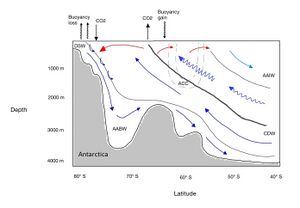
دورة انقلاب المحيط الجنوبي (Southern Ocean overturning circulation)، يشار إليه أحياناً باسم دورة انقلاب الزوال الجنوبي (Southern Meridional overturning circulation، اختصاراً SMOC)[1] أو دورة انقلاب أنتاركتيكا (Antarctic overturning circulation)، هو النصف الجنوبي من الدورة الحرارية الملحية العالمية، والتي تربط بين أحواض المياه المختلفة عبر المحيط العالمي. نظيره الشمالي الأكثر شهرة هو دورة انقلاب الزوال الأطلسي (AMOC). تبدأ هذه الدورة عندما ترسل تيارات معينة مياه دافئة مؤكسجة وفقيرة بالمغذيات إلى أعماق المحيط (التيار الهابط)، بينما تنتقل المياه الباردة المحدودة بالأكسجين والغنية بالمغذيات إلى الأعلى (أو التيار الصاعد) عند نقاط محددة. تنقل الدورة الحرارية الملحية ليس فقط كميات هائلة من المياه الدافئة والباردة عبر الكوكب، لكنها تنقل أيضًا الأكسجين المذاب والكربون العضوي المذاب وغيرها من المغذيات مثل الحديد.[2]
وبالتالي، فإن كلا نصفي الدورة لهما تأثير كبير على ميزانية طاقة الأرض ودورة الكربون المحيطية، وبالتالي يلعبان دورًا أساسيًا في نظام المناخ على الأرض.[3][4]
تتكون دورة انقلاب المحيط الجنوبي من جزأين، الخلية العلوية والخلية السفلية. تتأثر الخلية العلوية الأصغر بشكل أقوى بالرياح بسبب قربها من السطح، بينما يتحدد سلوك الخلية السفلية الأكبر من خلال درجة حرارة وملوحة مياه أنتاركتيكا القاعية.[5] لقد خضعت قوة كلا النصفين لتغيرات كبيرة في العقود الأخيرة: فقد زاد تدفق الخلية العلوية بنسبة 50-60% منذ السبعينيات، بينما ضعفت الخلية السفلية بنسبة 10-20%.[6][3] يرجع جزء هذا إلى الدورة الطبيعية تذبذب المحيط الهادي العقدي،[7][8] لكن تغير المناخ لعب أيضًا دورًا كبيرًا في كلا الاتجاهين، حيث أدى إلى تغيير نمط الوضع الحلقي الجنوبي الطقسي،[9][7] في حين أن النمو الهائل للمحتوى الحراري في المحيط الجنوبي[10] أدى إلى زيادة ذوبان الصفائح الجليدية في أنتاركتيكا، وهذه المياه الذائبة العذبة تعمل على تخفيف مياه أنتاركتيكا القاعية المالحة.[11][12]
ومع ضعف تشكل المياه الكثيفة والباردة بالقرب من الساحل، في حين يتعزز تدفق المياه الدافئة نحو الساحل، تصبح المياه السطحية أقل عرضة للهبوط إلى الأسفل والاختلاط بالطبقات السفلية.[13] وبالتالي، فإن عملية تطبق المحيط تزداد.[6][3] تشير إحدى الدراسات إلى أن الدورة سوف تفقد نصف قوتها بحلول عام 2050 في ظل أسوأ سيناريو لتغير المناخ،[14] مع حدوث خسائر أكبر لاحقاً.[15] إن هذا التباطؤ من شأنه أن يخلف تأثيرات مهمة على المناخ العالمي بسبب قوة المحيط الجنوبي كمصدر للكربون والحرارة على مستوى العالم. على سبيل المثال، سوف يصل الاحترار العالمي إلى 2 °C (3.6 °F) في جميع السيناريوهات التي لم تنخفض فيها الانبعاثات العالمية لغازات الدفيئة بشكل كبير، لكن العام المحدد يعتمد على حالة الدورة أكثر من أي عامل آخر غير الانبعاثات الإجمالية.[16]
تشير الأدلة المناخية القديمة إلى أن الدورة بأكملها قد ضعفت بشدة أو انهارت تمامًا من قبل: تشير بعض الأبحاث الأولية إلى أن مثل هذا الانهيار قد يصبح محتملًا بمجرد أن يصل الاحترار العالمي إلى مستويات تتراوح بين 1.7 °C (3.1 °F) و3 °C (5.4 °F). ومع ذلك، فإن اليقين أقل بكثير من التقديرات لمعظم نقاط التحول الأخرى في النظام المناخي.[16] حتى لو بدأ في المستقبل القريب، فمن غير المرجح أن يكتمل انهيار الدورة الدموية قبل عام 2300 تقريباً،[1] وعلى نحو مماثل، من المتوقع أيضًا أن تتكشف تأثيرات مثل انخفاض تساقط الأمطار في نصف الكرة الجنوبي، مع زيادة مقابلة في نصف الكرة الشمالي، أو تراجع مصائد الأسماك في المحيط الجنوبي مع احتمال انهيار بعض النظم البيئية البحرية، على مدى قرون متعددة.[15]
Dynamics
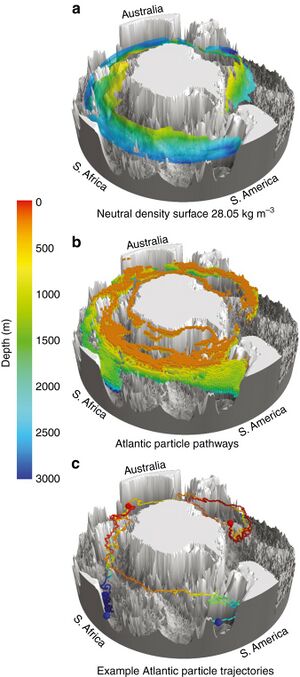
Southern Ocean overturning circulation consists of two cells in the Southern Ocean, which are driven by upwelling and downwelling. The upwelling in the upper cell is associated with mid-deep water that is brought to the surface, whereas the upwelling in the lower cell is linked to the fresh and abyssal waters around Antarctica. Around 27 ± 7 Sverdrup (Sv) of deep water wells up to the surface in the Southern Ocean. This upwelled water is partly transformed to lighter water and denser water, respectively 22 ± 4 Sv and 5 ± 5 Sv. The densities of these waters change due to heat and buoyancy fluxes which result in upwelling in the upper cell and downwelling in the lower cell.[5]
The Southern Ocean plays a key role in the closure of the Atlantic meridional overturning circulation by compensating for the North Atlantic downwelling by upwelling of North Atlantic Deep Water and connects the interior ocean to the surface. This upwelling is induced by the strong westerly winds that blow over the ACC.[4][17] Observations suggest that approximately 80 percent of global deep water is upwelled in the Southern Ocean.[18] Circulation is a slow process - for instance, the upwelling of North Atlantic Deep Water from the depths of 1,000–3,500 m (3,281–11,483 ft) to the surface mixed layer takes 60–90 years for just half of the water mass, and some water travels to the surface for more than a century.[17]
Upper cell
The upper cell is driven by wind generated flow, a result of the Westerlies, that brings water from the Circumpolar Deep Water (CDW) to the surface.[19] Zonal wind stress induces upwelling near the pole and downwelling at the equator due to the zonal surface-wind maximum. This wind-driven circulation is also called the Deacon cell and acts to overturn water supporting the thermal wind current of the Antarctic Circumpolar Current (ACC) and creating a storage of potential energy. This upper cell process is also known as Ekman transport.[4]
The meridional overturning flow is from the north to the south in deep waters and from the south to the north at the ocean surface. At the surface deep waters are exposed to the atmosphere and surface buoyancy forces. There is a net gain of buoyancy in the upper cell as a result of the freshening of the water caused by precipitation and the melting of sea ice during summer (on the Southern Hemipshere). This buoyancy gain transforms the waters into lighter, less dense waters, such as Subantarctic Mode Water (SAMW) and Antarctic Intermediate Water (AAIW). Around 22 ± 4 Sv of the total upwelled water in the overturning circulation is transformed into lighter waters in the upper cell. The overturning process of density surfaces is balanced through the baroclinic instability of the thermal wind currents. This instability flattens the density surfaces and the transport towards the poles, resulting in energetic, time-dependent eddying motions. The potential energy from the wind-driven circulation is then flattened out by eddies.[5]
Missing-mixing paradox
The missing-mixing paradox assumes that dense water is upwelled through the thermocline to close the circulation. To achieve this, vertical mixing is needed in the thermocline, which is not observed.[20] Instead, dense water from sinking regions returned to the surface in nearly adiabatic pathways along density isopycnals, which was already written by Harald Sverdrup (oceanographer).[21]
Lower cell
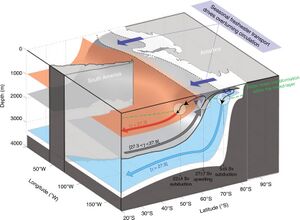
The lower cell is driven by freshwater fluxes where sea-ice formation and melting play an important role.[5] The formation of sea-ice is accompanied by brine rejection, resulting in water with a higher salinity and density and therefore buoyancy loss. When ice melts there is a freshwater flow and exposure to the atmosphere. If water turns into ice, there is more salt in the water and less exposure to the atmosphere. Due to seasonal variations, there is a gain of buoyancy during summer and a loss of buoyancy in winter. This cold and dense water filled with salt is called Dense Shelf Water (DSW). DSW is then transformed into Antarctic Bottom Water (AABW), originating from the Ross Sea, Weddell Sea and along the eastern coast of Antarctica. Around 5 ± 5 Sv of AABW is formed in the lower cell of the Southern Ocean circulation, which is around a third of the total AABW formation.[22][23][24]
Global carbon cycle
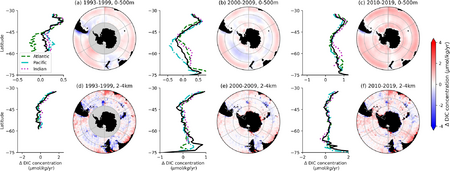
The ocean is in normally in equilibrium with the atmospheric carbon dioxide concentration. The increase in atmospheric CO2 since the Industrial Revolution had turned the oceans into a net carbon sink, and they absorb around 25% of human-caused emissions.[26] Out of all oceans, the Southern Ocean plays the greatest role in carbon uptake, and on its own, it is responsible for around 40%.[27][28][29] In 2000s, some research suggested that climate-driven changes to Southern Hemisphere winds were reducing the amount of carbon it absorbed,[30] but subsequent research found that this carbon sink had been even stronger than estimated earlier, by some 14% to 18%.[27][28] Ocean circulation is very important for this process, as it brings deep water to the surface, which has not been there for centuries and so wasn't in contact with anthropogenic emissions before. Thus, deep water's dissolved carbon concentrations are much lower than of the modern surface waters, and it absorbs a lot more carbon before it's transported back to the depths through downwelling.[31][25]
On the other hand, regions where deep warm circumpolar carbon rich waters are brought to the surface through upwelling, outgas CO2 through exposure to the atmosphere, partly compensating the carbon sink effect of the overturning circulation.[32] Additionally, ocean upwelling brings mineral nutrients such as iron from the depths to the surface, which are then consumed by phytoplankton and allow them to increase their numbers, enhancing ocean primary production and boosting the carbon sink due to greater photosynthesis.[2] At the same time, downwelling circulation moves much of dead phytoplankton and other organic matter to the depths before it could decompose at the surface and release CO2 back to the atmosphere. This so-called biological pump is so important that a completely abiotic Southern Ocean, where this pump would be absent, would also be a net source of CO2.[29]
آثار تغير المناخ

وبما أن انبعاثات غازات الدفيئة الناجمة عن النشاط البشري تسبب ارتفاع درجات الحرارة، فإن أحد أبرز تأثيرات تغير المناخ على المحيطات هو زيادة محتوى الحراري للمحيط، والذي يمثل أكثر من 90% من إجمالي الاحترار العالمي منذ عام 1971.[36] منذ عام 2005، من 67% إلى 98% من هذه الزيادة حدثت في المحيط الجنوبي.[9] في غرب أنتاركتيكا، ارتفعت درجة الحرارة في الطبقة العليا من المحيط بمقدار درجة واحدة مئوية منذ عام 1955، كما أن تيار أنتاركتيكا القطبي يرتفع أيضًا بشكل أسرع من المتوسط العالمي.[37]
يؤثر هذا الاحترار بشكل مباشر على تدفق الكتل المائية الدافئة والباردة التي تشكل الدورة الانقلابية، كما أن له تأثيرات سلبية على غطاء الجليد البحري في نصف الكرة الجنوبي (الذي يتميز بقدرة عالية على الانعكاس وبالتالي يرفع من مستوى نصوع سطح الأرض)، بالإضافة إلى توازن الكتلة في الأرصفة الجليدية في أنتاركتيكا والمثالج الطرفية.[38] لهذه الأسباب، تظهر نماذج المناخ باستمرار أن العام الذي سيصل فيه الانحباس الحراري العالمي إلى -2° مئوية (وهو أمر لا مفر منه في جميع سيناريوهات تغير المناخ حيث لم تنخفض انبعاثات غازات الدفيئة بشكل كبير) يعتمد على حالة الدورة أكثر من أي عامل آخر إلى جانب الانبعاثات نفسها.[16]
يؤدي الاحترار الأكبر لمياه المحيط إلى زيادة فقدان الجليد من قارة أنتاركتيكا، كما يؤدي أيضًا إلى توليد المزيد من مياه الجليد الذائبة العذبة، بمعدل 1100-1500 بليون طن سنويًا.[38] This meltwater from the Antarctic ice sheet then mixes back into the Southern Ocean, making its water fresher.[39] يؤدي هذا التجدد في المحيط الجنوبي إلى زيادة التطبق واستقرار طبقاته،[40][38] and this has the single largest impact on the long-term properties of Southern Ocean circulation.[14] تتسبب هذه التغيرات في المحيط الجنوبي في تسريع دوران الخلايا العلوية، مما يؤدي إلى تسريع تدفق التيارات الرئيسية،[41] في حين يتباطأ دوران الخلايا السفلي، لأنه يعتمد على مياه أنتاركتيكا القاعية شديدة الملوحة، والتي يبدو أنها قد ضعفت بالفعل بشكل ملحوظ بسبب التجديد، على الرغم من التعافي المحدود خلال عقد 2010.[11][42][43][38] منذ السبعينيات، تعززت الخلية العلوية بمقدار 3-4 سڤردروپ (Sv؛ تمثل تدفقًا بمعدل مليون متر مكعب في الثانية)أو 50-60% من تدفقها، في حين ضعفت الخلية السفلية بمقدار مماثل، ولكن بسبب حجمها الأكبر، تمثل هذه التغييرات ضعفًا بنسبة 10-20%.[6][3] ومع ذلك، لم تكن ناجمة بالكامل عن تغير المناخ، حيث لعبت الدورة الطبيعية لتذبذب المحيط الهادي العقدي دوراً هاماً أيضاً.[7][8]
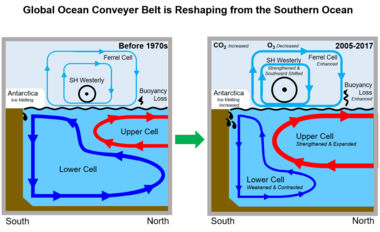
بالإضافة إلى ذلك، فإن النمط الرئيسي المتحكم في مناخ نصف الكرة الجنوبي فوق المداري هو الوضع الحلقي الجنوبي (SAM)، والذي قضى سنوات عديدة في مرحلته الإيجابية بسبب تغير المناخ (وكذلك في أعقاب استنزاف الأوزون)، مما يعني المزيد من الاحترار والمزيد من سقوط الأمطار فوق المحيط بسبب الرياح الغربية الأقوى، مما يؤدي إلى تجدد المحيط الجنوبي بشكل أكبر.[9][38] لا تتفق نماذج المناخ حاليًا على ما إذا كانت دورة المحيط الجنوبي ستستمر في الاستجابة للتغيرات في الوضع الحلقي الجنوبي بالطريقة التي تفعلها الآن، أو ما إذا كانت ستتكيف معها في النهاية. اعتبارًا من أوائل ع. 2020، فإن أفضل تقديراتهم المحدودة الثقة هي أن الخلية السفلية ستستمر في الضعف، بينما قد تتعزز الخلية العلوية بنحو 20% على مدار القرن 21.[38] أحد الأسباب الرئيسية لعدم اليقين هو التمثيل الضعيف وغير المتسق لطبقات المحيطات حتى في نماذج مشروع مقارنة النماذج CMIP6- وهو الجيل الأكثر تقدمًا المتاح اعتبارًا من أوائل ع. 2020.[10] علاوة على ذلك، فإن الدور الأكبر على المدى الطويل في حالة الدورة يلعبه الماء الذائب في أنتاركتيكا،[14] وكان فقدان الجليد في أنتاركتيكا هو الجانب الأقل يقيناً في توقعات ارتفاع مستوى سطح البحر في المستقبل لفترة طويلة.[44]
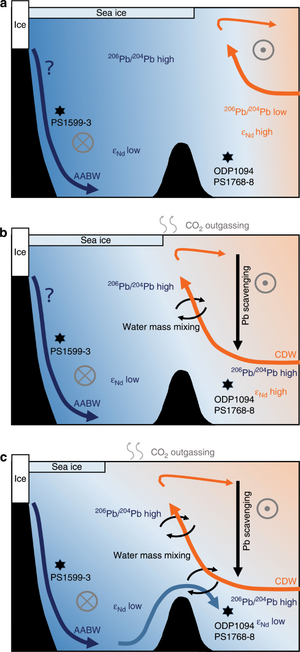
تجري عمليات مماثلة مع دورة انقلاب المحيط الأطلسي (AMOC)، والتي تتأثر أيضًا بارتفاع درجة حرارة المحيط وتدفقات المياه الذائبة من صفيحة گرينلاند الجليدية.[46] ومن الممكن أن تستمر كلتا الدورتين في الضعف ليس فقط استجابة لارتفاع درجات الحرارة والتجدد، بل قد تنهار في نهاية المطاف إلى حالة أضعف كثيراً، على نحو قد يكون من الصعب عكسه ويشكل مثالاً على نقاط التحول في النظام المناخي.[16] هناك أدلة مناخية قديمة تشير إلى أن الدورة الانقلابية كانت أضعف بكثير مما هي عليه الآن خلال الفترات الماضية التي كانت أكثر دفئًا وبرودة من الآن.[45] ومع ذلك، لا يسكن نصف الكرة الجنوبي سوى 10% من سكان العالم، وقد حظيت دورة انقلاب المحيط الجنوبي تاريخيًا باهتمام أقل بكثير من نظيرتها في المحيط الأطلسي. وبالتالي، في حين وُضعت دراسات متعددة لتقدير المستوى الدقيق للاحترار العالمي الذي قد يؤدي إلى انهيار دورة انقلاب المحيط الأطلسي، والإطار الزمني الذي قد يحدث خلاله مثل هذا الانهيار، والتأثيرات الإقليمية التي قد يسببها، إلا أن الأبحاث المكافئة لدورة انقلاب المحيط الجنوبي أقل بكثير من أوائل ع. 2020. كان هناك اقتراح بأن انهياره قد يحدث بين -1.7° مئوية و-4° مئوية،لكن هذا التقدير أقل يقينًا بكثير من العديد من نقاط التحول الأخرى.[16]
كما أن تأثيرات دورة انقلاب المحيط الجنوبي لم تُدرشج بشكل موثق، على الرغم من أن العلماء يتوقعون أن تتكشف على مدى قرون عديدة. ومن الأمثلة البارزة على ذلك فقدان المغذيات من مياه أنتاركتيكا القاعية مما يؤدي إلى تقليص إنتاجية المحيط وفي نهاية المطاف حالة مصايد الأسماك في المحيط الجنوبي، مما قد يؤدي إلى انقراض بعض أنواع الأسماك، وانهيار بعض النظم البيئية البحرية.[15] كما يعني انخفاض الإنتاجية البحرية أن المحيط يمتص كمية أقل من الكربون (على الرغم من أنه لن يحدث خلال القرن 21)[10])، مما قد يؤدي إلى زيادة الاحترار النهائي على المدى الطويل استجابة للانبعاثات الناجمة عن الأنشطة البشرية (وبالتالي زيادة حساسية المناخ الإجمالية) و/أو إطالة فترة استمرار الاحترار قبل أن يبدأ في الانخفاض على المقاييس الزمنية الجيولوجية.[1] ومن المتوقع أيضًا أن يحدث انخفاض في تساقط الأمطار في بلدان نصف الكرة الجنوبي مثل أستراليا، مع زيادة مماثلة في نصف الكرة الشمالي. ومع ذلك، فإن تراجع أو انهيار دورة انقلاب المحيط الأطلسي سيكون له تأثيرات متشابهة ولكنها معاكسة، وسيعمل كلاهما على مواجهة بعضهما البعض حتى نقطة معينة. كما سيحدث كلا التأثيرين جنبًا إلى جنب مع تأثيرات تغير المناخ الأخرى على دورة المياه ومصائد الأسماك.[15]
المصادر
- ^ أ ب ت Liu, Y.; Moore, J. K.; Primeau, F.; Wang, W. L. (22 December 2022). "Reduced CO2 uptake and growing nutrient sequestration from slowing overturning circulation". Nature Climate Change. 13: 83–90. doi:10.1038/s41558-022-01555-7. OSTI 2242376. S2CID 255028552.
- ^ أ ب Schine, Casey M. S.; Alderkamp, Anne-Carlijn; van Dijken, Gert; Gerringa, Loes J. A.; Sergi, Sara; Laan, Patrick; van Haren, Hans; van de Poll, Willem H.; Arrigo, Kevin R. (22 February 2021). "Massive Southern Ocean phytoplankton bloom fed by iron of possible hydrothermal origin". Nature Communications. 12 (1): 1211. Bibcode:2021NatCo..12.1211S. doi:10.1038/s41467-021-21339-5. PMC 7900241. PMID 33619262.
- ^ أ ب ت ث ج "NOAA Scientists Detect a Reshaping of the Meridional Overturning Circulation in the Southern Ocean". NOAA. 29 March 2023.
- ^ أ ب ت Marshall, John; Speer, Kevin (26 February 2012). "Closure of the meridional overturning circulation through Southern Ocean upwelling". Nature Geoscience. 5 (3): 171–180. Bibcode:2012NatGe...5..171M. doi:10.1038/ngeo1391.
- ^ أ ب ت ث ج Pellichero, Violaine; Sallée, Jean-Baptiste; Chapman, Christopher C.; Downes, Stephanie M. (3 May 2018). "The southern ocean meridional overturning in the sea-ice sector is driven by freshwater fluxes". Nature Communications. 9 (1): 1789. Bibcode:2018NatCo...9.1789P. doi:10.1038/s41467-018-04101-2. PMC 5934442. PMID 29724994.
- ^ أ ب ت Lee, Sang-Ki; Lumpkin, Rick; Gomez, Fabian; Yeager, Stephen; Lopez, Hosmay; Takglis, Filippos; Dong, Shenfu; Aguiar, Wilton; Kim, Dongmin; Baringer, Molly (13 March 2023). "Human-induced changes in the global meridional overturning circulation are emerging from the Southern Ocean". Communications Earth & Environment. 4 (1): 69. Bibcode:2023ComEE...4...69L. doi:10.1038/s43247-023-00727-3.
- ^ أ ب ت Zhou, Shenjie; Meijers, Andrew J. S.; Meredith, Michael P.; Abrahamsen, E. Povl; Holland, Paul R.; Silvano, Alessandro; Sallée, Jean-Baptiste; Østerhus, Svein (12 June 2023). "Slowdown of Antarctic Bottom Water export driven by climatic wind and sea-ice changes". Nature Climate Change. 13: 701–709. doi:10.1038/s41558-023-01667-8.
- ^ أ ب Silvano, Alessandro; Meijers, Andrew J. S.; Zhou, Shenjie (17 June 2023). "Slowing deep Southern Ocean current may be linked to natural climate cycle—but melting Antarctic ice is still a concern". The Conversation.
- ^ أ ب ت Stewart, K. D.; Hogg, A. McC.; England, M. H.; Waugh, D. W. (2 November 2020). "Response of the Southern Ocean Overturning Circulation to Extreme Southern Annular Mode Conditions". Geophysical Research Letters. 47 (22): e2020GL091103. Bibcode:2020GeoRL..4791103S. doi:10.1029/2020GL091103. hdl:1885/274441. S2CID 229063736.
- ^ أ ب ت ث Bourgeois, Timothée; Goris, Nadine; Schwinger, Jörg; Tjiputra, Jerry F. (17 January 2022). "Stratification constrains future heat and carbon uptake in the Southern Ocean between 30°S and 55°S". Nature Communications. 13 (1): 340. Bibcode:2022NatCo..13..340B. doi:10.1038/s41467-022-27979-5. PMC 8764023. PMID 35039511.
- ^ أ ب Silvano, Alessandro; Rintoul, Stephen Rich; Peña-Molino, Beatriz; Hobbs, William Richard; van Wijk, Esmee; Aoki, Shigeru; Tamura, Takeshi; Williams, Guy Darvall (18 April 2018). "Freshening by glacial meltwater enhances the melting of ice shelves and reduces the formation of Antarctic Bottom Water". Science Advances. 4 (4): eaap9467. doi:10.1126/sciadv.aap9467. PMC 5906079. PMID 29675467.
- ^ Ribeiro, N.; Herraiz‐Borreguero, L.; Rintoul, S. R.; McMahon, C. R.; Hindell, M.; Harcourt, R.; Williams, G. (15 July 2021). "Warm Modified Circumpolar Deep Water Intrusions Drive Ice Shelf Melt and Inhibit Dense Shelf Water Formation in Vincennes Bay, East Antarctica". Journal of Geophysical Research: Oceans (in الإنجليزية). 126 (8). doi:10.1029/2020JC016998. ISSN 2169-9275.
- ^ Chen, Jia‐Jia; Swart, Neil C.; Beadling, Rebecca; Cheng, Xuhua; Hattermann, Tore; Jüling, André; Li, Qian; Marshall, John; Martin, Torge; Muilwijk, Morven; Pauling, Andrew G.; Purich, Ariaan; Smith, Inga J.; Thomas, Max (28 December 2023). "Reduced Deep Convection and Bottom Water Formation Due To Antarctic Meltwater in a Multi‐Model Ensemble". Geophysical Research Letters (in الإنجليزية). 50 (24). doi:10.1029/2023GL106492. ISSN 0094-8276.
- ^ أ ب ت Li, Qian; England, Matthew H.; Hogg, Andrew McC.; Rintoul, Stephen R.; Morrison, Adele K. (29 March 2023). "Abyssal ocean overturning slowdown and warming driven by Antarctic meltwater". Nature. 615 (7954): 841–847. Bibcode:2023Natur.615..841L. doi:10.1038/s41586-023-05762-w. PMID 36991191. S2CID 257807573.
- ^ أ ب ت ث Logan, Tyne (29 March 2023). "Landmark study projects 'dramatic' changes to Southern Ocean by 2050". ABC News.
- ^ أ ب ت ث ج Lenton, T. M.; Armstrong McKay, D.I.; Loriani, S.; Abrams, J.F.; Lade, S.J.; Donges, J.F.; Milkoreit, M.; Powell, T.; et al. (2023). The Global Tipping Points Report 2023. University of Exeter. Archived from the original. You must specify the date the archive was made using the
|archivedate=parameter. https://global-tipping-points.org/download/4608/. - ^ أ ب ت Tamsitt, Veronica; Drake, Henri F.; Morrison, Adele K.; Talley, Lynne D.; Dufour, Carolina O.; Gray, Alison R.; Griffies, Stephen M.; Mazloff, Matthew R.; Sarmiento, Jorge L.; Wang, Jinbo; Weijer, Wilbert (2 August 2017). "Spiraling pathways of global deep waters to the surface of the Southern Ocean". Nature Communications. 8 (1): 172. Bibcode:2017NatCo...8..172T. doi:10.1038/s41467-017-00197-0. PMC 5541074. PMID 28769035.
- ^ Talley, Lynne (2013). "Closure of the Global Overturning Circulation Through the Indian, Pacific, and Southern Oceans: Schematics and Transports". Oceanography. 26 (1): 80–97. doi:10.5670/oceanog.2013.07. JSTOR 24862019.
- ^ Gill, A.E.; Green, J.S.A.; Simmons, A.J. (1974). "Energy partition in the large-scale ocean circulation and the production of mid-ocean eddies". Deep Sea Research and Oceanographic Abstracts. 21 (7): 499–528. Bibcode:1974DSRA...21..499G. doi:10.1016/0011-7471(74)90010-2.
- ^ St. Laurent, L. C.; Ledwell, J. R.; Girton, J. B.; Toole, J. M. (2011). "Diapycnal Mixing in the Antarctic Circumpolar Current". Journal of Physical Oceanography. 41 (1): 241–246. Bibcode:2011JPO....41..241L. doi:10.1175/2010JPO4557.1. hdl:1912/4409. S2CID 55251243.
- ^ Sverdrup, H. U. On vertical circulation in the ocean due to the action of the wind with application to conditions within the Antarctic Circumpolar Current. Discov. Rep. VII, 139–170 (1933).
- ^ Tamura, Takeshi; Ohshima, Kay I.; Nihashi, Sohey (2008). "Mapping of sea ice production for Antarctic coastal polynyas". Geophysical Research Letters. 35 (7). Bibcode:2008GeoRL..35.7606T. doi:10.1029/2007GL032903. S2CID 128716199.
- ^ Williams, G. et al. Antarctic bottom water from the adélie and george v land coast, east antarctica (140–149°e). J. Geophys. Res. Oceans 115 (2010)
- ^ Ohshima, Kay I.; Fukamachi, Yasushi; Williams, Guy D.; Nihashi, Sohey; Roquet, Fabien; Kitade, Yujiro; Tamura, Takeshi; Hirano, Daisuke; Herraiz-Borreguero, Laura; Field, Iain; Hindell, Mark; Aoki, Shigeru; Wakatsuchi, Masaaki (2013). "Antarctic Bottom Water production by intense sea-ice formation in the Cape Darnley polynya". Nature Geoscience. 6 (3): 235. Bibcode:2013NatGe...6..235O. doi:10.1038/ngeo1738.
- ^ أ ب Zemskova, Varvara E.; He, Tai-Long; Wan, Zirui; Grisouard, Nicolas (13 July 2022). "A deep-learning estimate of the decadal trends in the Southern Ocean carbon storage". Nature Communications. 13 (1): 4056. Bibcode:2022NatCo..13.4056Z. doi:10.1038/s41467-022-31560-5. PMC 9279406. PMID 35831323.
- ^ Friedlingstein, Pierre; O'Sullivan, Michael; Jones, Matthew W.; et al. (5 December 2023). "Global Carbon Budget 2023". Earth System Science Data. 15 (12): 5301–5369. doi:10.5194/essd-15-5301-2023. hdl:10871/134742.
- ^ أ ب Long, Matthew C.; Stephens, Britton B.; McKain, Kathryn; Sweeney, Colm; Keeling, Ralph F.; Kort, Eric A.; Morgan, Eric J.; Bent, Jonathan D.; Chandra, Naveen; Chevallier, Frederic; Commane, Róisín; Daube, Bruce C.; Krummel, Paul B.; Loh, Zoë; Luijkx, Ingrid T.; Munro, David; Patra, Prabir; Peters, Wouter; Ramonet, Michel; Rödenbeck, Christian; Stavert, Ann; Tans, Pieter; Wofsy, Steven C. (2 December 2021). "Strong Southern Ocean carbon uptake evident in airborne observations". Science. 374 (6572): 1275–1280. Bibcode:2021Sci...374.1275L. doi:10.1126/science.abi4355. PMID 34855495. S2CID 244841359.
- ^ أ ب Terhaar, Jens; Frölicher, Thomas L.; Joos, Fortunat (28 April 2021). "Southern Ocean anthropogenic carbon sink constrained by sea surface salinity" (PDF). Science Advances. 7 (18): 1275–1280. Bibcode:2021Sci...374.1275L. doi:10.1126/science.abi4355. PMID 34855495. S2CID 244841359.
- ^ أ ب Huang, Yibin; Fassbender, Andrea J.; Bushinsky, Seth M. (26 April 2023). "Biogenic carbon pool production maintains the Southern Ocean carbon sink". Proceedings of the National Academy of Sciences. 120 (18): e2217909120. Bibcode:2023PNAS..12017909H. doi:10.1073/pnas.2217909120. PMC 10160987.
- ^ Le QuéRé, Corinne; RöDenbeck, Christian; Buitenhuis, Erik T.; Conway, Thomas J.; Langenfelds, Ray; Gomez, Antony; Labuschagne, Casper; Ramonet, Michel; Nakazawa, Takakiyo; Metzl, Nicolas; Gillett, Nathan; Heimann, Martin (22 June 2007). "Saturation of the Southern Ocean CO 2 Sink Due to Recent Climate Change". Science. 316 (5832): 1735–1738. doi:10.1126/science.1136188. PMID 17510327. S2CID 34642281.
- ^ Devries, Tim; Primeau, François (2011). "Dynamically and Observationally Constrained Estimates of Water-Mass Distributions and Ages in the Global Ocean". Journal of Physical Oceanography. 41 (12): 2381–2401. Bibcode:2011JPO....41.2381D. doi:10.1175/JPO-D-10-05011.1. S2CID 42020235.
- ^ Lauderdale, Jonathan M.; Williams, Richard G.; Munday, David R.; Marshall, David P. (2017). "The impact of Southern Ocean residual upwelling on atmospheric CO2 on centennial and millennial timescales". Climate Dynamics. 48 (5–6): 1611–1631. doi:10.1007/s00382-016-3163-y. hdl:1721.1/107158. S2CID 56324078.
- ^ Hausfather, Zeke; Peters, Glen (29 January 2020). "Emissions – the 'business as usual' story is misleading". Nature. 577 (7792): 618–20. Bibcode:2020Natur.577..618H. doi:10.1038/d41586-020-00177-3. PMID 31996825.
- ^ Phiddian, Ellen (5 April 2022). "Explainer: IPCC Scenarios". Cosmos. Retrieved 30 September 2023.
"The IPCC doesn't make projections about which of these scenarios is more likely, but other researchers and modellers can. The Australian Academy of Science, for instance, released a report last year stating that our current emissions trajectory had us headed for a 3°C warmer world, roughly in line with the middle scenario. Climate Action Tracker predicts 2.5 to 2.9°C of warming based on current policies and action, with pledges and government agreements taking this to 2.1°C.
- ^ IPCC, 2021: Summary for Policymakers. In: Climate Change 2021: The Physical Science Basis. Contribution of Working Group I to the Sixth Assessment Report of the Intergovernmental Panel on Climate Change [Masson-Delmotte, V., P. Zhai, A. Pirani, S.L. Connors, C. Péan, S. Berger, N. Caud, Y. Chen, L. Goldfarb, M. I. Gomis, M. Huang, K. Leitzell, E. Lonnoy, J. B. R. Matthews, T. K. Maycock, T. Waterfield, O. Yelekçi, R. Yu, and B. Zhou (eds.)]. Cambridge University Press, Cambridge, United Kingdom and New York, New York, US, pp. 3−32, doi:10.1017/9781009157896.001.
- ^ von Schuckmann, K.; Cheng, L.; Palmer, M. D.; Hansen, J.; et al. (7 September 2020). "Heat stored in the Earth system: where does the energy go?". Earth System Science Data. 12 (3): 2013–2041. Bibcode:2020ESSD...12.2013V. doi:10.5194/essd-12-2013-2020. hdl:20.500.11850/443809.
 Text was copied from this source, which is available under a Creative Commons Attribution 4.0 International License
Text was copied from this source, which is available under a Creative Commons Attribution 4.0 International License
- ^ "Impacts of climate change". Discovering Antarctica (in الإنجليزية البريطانية). Retrieved 15 May 2022.
- ^ أ ب ت ث ج ح Fox-Kemper, B.; Hewitt, H.T.; Xiao, C.; Aðalgeirsdóttir, G.; Drijfhout, S.S.; Edwards, T.L.; Golledge, N.R.; Hemer, M.; Kopp, R.E.; Krinner, G.; Mix, A. (2021). "Ocean, Cryosphere and Sea Level Change". In Masson-Delmotte, V.; Zhai, P.; Pirani, A.; Connors, S.L.; Péan, C.; Berger, S.; Caud, N.; Chen, Y.; Goldfarb, L. (eds.). Climate Change 2021: The Physical Science Basis. Contribution of Working Group I. Sixth Assessment Report of the Intergovernmental Panel on Climate Change. Vol. 2021. Cambridge University Press. pp. 1239–1241. doi:10.1017/9781009157896.011. ISBN 9781009157896.
- ^ Pan, Xianliang L.; Li, Bofeng F.; Watanabe, Yutaka W. (10 January 2022). "Intense ocean freshening from melting glacier around the Antarctica during early twenty-first century". Scientific Reports (in الإنجليزية). 12 (1): 383. Bibcode:2022NatSR..12..383P. doi:10.1038/s41598-021-04231-6. ISSN 2045-2322. PMC 8748732. PMID 35013425.
- ^ Haumann, F. Alexander; Gruber, Nicolas; Münnich, Matthias; Frenger, Ivy; Kern, Stefan (September 2016). "Sea-ice transport driving Southern Ocean salinity and its recent trends". Nature (in الإنجليزية). 537 (7618): 89–92. Bibcode:2016Natur.537...89H. doi:10.1038/nature19101. hdl:20.500.11850/120143. ISSN 1476-4687. PMID 27582222. S2CID 205250191.
- ^ Shi, Jia-Rui; Talley, Lynne D.; Xie, Shang-Ping; Peng, Qihua; Liu, Wei (2021-11-29). "Ocean warming and accelerating Southern Ocean zonal flow". Nature Climate Change. Springer Science and Business Media LLC. 11 (12): 1090–1097. Bibcode:2021NatCC..11.1090S. doi:10.1038/s41558-021-01212-5. ISSN 1758-678X. S2CID 244726388.
- ^ Aoki, S.; Yamazaki, K.; Hirano, D.; Katsumata, K.; Shimada, K.; Kitade, Y.; Sasaki, H.; Murase, H. (15 September 2020). "Reversal of freshening trend of Antarctic Bottom Water in the Australian-Antarctic Basin during 2010s". Scientific Reports (in الإنجليزية). 10 (1): 14415. doi:10.1038/s41598-020-71290-6. PMC 7492216. PMID 32934273.
- ^ Gunn, Kathryn L.; Rintoul, Stephen R.; England, Matthew H.; Bowen, Melissa M. (25 May 2023). "Recent reduced abyssal overturning and ventilation in the Australian Antarctic Basin". Nature Climate Change (in الإنجليزية). 13 (6): 537–544. Bibcode:2023NatCC..13..537G. doi:10.1038/s41558-023-01667-8. ISSN 1758-6798.
- ^ Robel, Alexander A.; Seroussi, Hélène; Roe, Gerard H. (23 July 2019). "Marine ice sheet instability amplifies and skews uncertainty in projections of future sea-level rise". Proceedings of the National Academy of Sciences. 116 (30): 14887–14892. Bibcode:2019PNAS..11614887R. doi:10.1073/pnas.1904822116. PMC 6660720. PMID 31285345.
- ^ أ ب Huang, Huang; Gutjahr, Marcus; Eisenhauer, Anton; Kuhn, Gerhard (22 January 2020). "No detectable Weddell Sea Antarctic Bottom Water export during the Last and Penultimate Glacial Maximum". Nature Communications. 11. doi:10.1038/s41467-020-14302-3. PMC 6976697.
- ^ Bakker, P; Schmittner, A; Lenaerts, JT; Abe-Ouchi, A; Bi, D; van den Broeke, MR; Chan, WL; Hu, A; Beadling, RL; Marsland, SJ; Mernild, SH; Saenko, OA; Swingedouw, D; Sullivan, A; Yin, J (11 November 2016). "Fate of the Atlantic Meridional Overturning Circulation: Strong decline under continued warming and Greenland melting". Geophysical Research Letters. 43 (23): 12, 252–12, 260. Bibcode:2016GeoRL..4312252B. doi:10.1002/2016GL070457. hdl:10150/622754. S2CID 133069692.